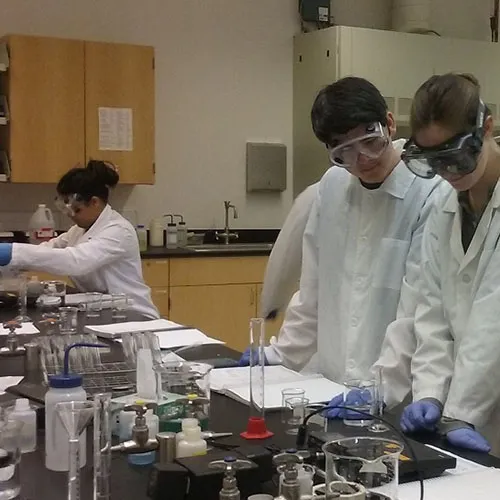
NSF Grants - MRI Grant
NSF MRI Grant - LC/MS/MS

This MRI grant supported the purchase of a high performance liquid chromatograph with a photodiode array detector and triple quadrupole mass spectrometer (LC/MS/MS), which is the first instrument of its type to be housed at a university in southern Colorado. This instrument was utilized by faculty at the University of Colorado Colorado Springs (UCCS), Colorado College (CC), and in collaborative research projects with the toxicologists of the El Paso County Coroner’s Office Toxicology Laboratory. Additionally, the instrument enhanced laboratory course experiences of undergraduate and graduate students at UCCS and CC.
Intellectual Merit
Researchers in a variety of chemical sub-disciplines, including analytical, environmental, and organic chemistry utilized the LC/MS/MS. This instrument acquisition supported the following research projects:
- Analysis of the brominated flame retardant tetrabromobisphenol-A (TBBPA), which is the most widely used flame retardant worldwide and has been found in a variety of environmental samples. Our methodology for analyzing TBBPA and its derivative, tribromobisphenol-A, is straightforward and has allowed for accurate and precise determination of these compounds in dust. Dust has been of significant research interest as an indoor sink for semi-volatile compounds that may adversely affect our health.
- Analysis of opiate drugs in forensically relevant post-mortem samples (brain and blood) to help determine the cause of death. Analysis of postmortem tissue for drugs can help determine cause and manner of death. The opportunity for students and faculty to partner with the toxicologists at the El Paso County Coroner's Office, which is the only on-site forensic toxicology laboratory associated with a coroner facility in the state of Colorado, is tremendous for advancing forensic analytical toxicology studies.
- Profiling of synthetic methods to produce cyclic hydroxamic acids, a functional group critical to the biological activity of drug candidates and natural products, including a potential drug candidate for treatment of Stage II human African trypanosomiasis (HAT), or African sleeping sickness. Current treatments for Stage II HAT are inadequate owing to poor safety profiles, marginal efficacy, and complex dosing profiles. A series of drug analogs were synthesized to explore other potential drug candidates with different safety profiles for treatment of HAT or efficacy in treatment of other neglected tropical diseases.
- Profiling of fluorinated analogs of amodiaquine, an anti-malaria drug. The need for improved, effective, and affordable drugs against drug-resistant malaria parasites is paramount. This drug class is active against certain resistant strains of malaria, though their clinical use is limited because of adverse side effects. The goal of this research is to make analogs that are more effective antimalarial drugs, thus saving tens of thousands of lives each year.
- Analysis of water, soil, and produce samples for concentrations of perfluorinated chemicals (PFCs). In early 2016, a number of reports were issued focusing on the contamination of drinking water utilities in the southern Colorado Springs metro area by PFCs, making Colorado one of 63 areas nationwide affected by these highly persistent pollutants. Exposure to PFCs is of concern because of their wide-ranging human health effects. These affected utilities provide drinking water to nearly 80,000 residents in southern Colorado at levels with many wells exceeding the EPA health advisory of 70 parts-per-trillion (ppt, or ng/L), necessitating the purchase of water from other municipalities. Given the cost of doing such extensive analyses on water soil, and food, UCCS students and faculty are capable of providing much needed support.
Broader Impacts: Acquiring the LC/MS/MS instrument has been hugely beneficial to our programs. At UCCS, it has significantly strengthened our student training because we have been able to incorporate the use of the instrument at all levels: undergraduate and graduate research; NSF REU programming; development of internship programs; coursework; and in community outreach. For CC, acquiring the instrument has allowed them to establish and participate in international programs in medicinal chemistry; involve undergraduate organic chemistry researchers to characterize complex synthetic mixtures; and to utilize the instrument in coursework. For the Toxicology Laboratory at El Paso County Coroner's Office, having this instrument has accelerated their method development, optimization, and validation for compounds that are toxicologically relevant.
Since the instrument was installed in January 2015, we have trained a total of 13 research students, four REU students, and thirty-two undergraduate students enrolled in upper-division courses at UCCS. Six undergraduate researchers from CC were trained on the instrument. Multiple graduate students use the instrument as well, with a significant increase in the numbers of students asking to join the MS program because of this unique instrument capability.
A total of thirty-one products, including peer-reviewed manuscripts, oral and poster presentations, and graduate theses, have been generated from the research results enabled by this instrument procurement. The instrument will be used heavily for years to come in research programs at UCCS and Colorado College.
For more information, please contact Janel Owens at jowens2@uccs.edu or 719-255-3207.